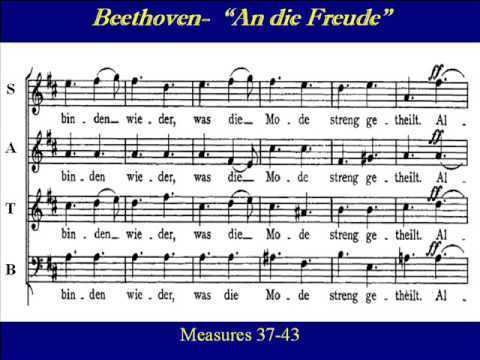Originally published 1786 | ||
 | ||
Works by Friedrich Schiller Song of the Bell, Der Handschuh, Die Bürgschaft, Xenien, The Criminal of Lost Hon | ||
"Ode to Joy" (German: "An die Freude" [an diː ˈfʁɔʏdə], first line: "Freude, schöner Götterfunken") is an ode written in the summer of 1785 by German poet, playwright, and historian Friedrich Schiller and published the following year in Thalia. A slightly revised version appeared in 1808, changing two lines of the first and omitting the last stanza.
Contents
- Beethoven ode to joy hd
- The poem
- Revisions
- Ode to Freedom
- Beethovens musical setting
- Uses as a theme song
- In popular culture
- Other musical settings
- References
"Ode to Joy" is best known for its use by Ludwig van Beethoven in the final (fourth) movement of his Ninth Symphony, completed in 1824. Beethoven's text does not use the entirety of Schiller's poem, and reorders some sections. His tune (but not Schiller's words) was adopted as the Anthem of Europe by the Council of Europe in 1972, and subsequently the European Union.
Beethoven ode to joy hd
The poem
Friedrich Schiller later made some revisions to the poem which was then republished posthumously in 1808, and it was this latter version that forms the basis for Beethoven's famous setting. Despite the lasting popularity of the ode, Schiller himself regarded it as a failure later in his life, going so far as calling it "detached from reality" and "of value maybe for us two, but not for the world, nor for the art of poetry" in an 1800 letter to his long-time friend and patron Christian Gottfried Körner (whose friendship had originally inspired him to write the ode).
The prominent experts Hans-Jürgen Schings, Wolfgang Riedel and Peter-André Alt accentuate the influence of the pietistic theologian Friedrich Christoph Oetinger upon Schiller's philosophy of love. Reinhard Breymayer has newly detected that Oetinger's former pastor Philipp Matthäus Hahn too had such influence upon Schiller and, moreover, a connection to the family of Maria Wilhelmine Countess von Thun und Hohenstein, remembered as the sponsor of a Vienna musically and intellectually outstanding salon and for her patronage of music, notably that of Mozart and Beethoven. Her husband, Franz Josef Count von Thun und Hohenstein, father-in-law of Mozart and Beethoven's patron Karl Alois, Prince Lichnowsky, ordered an astronomic machine constructed by Hahn and produced by Philipp Gottfried Schaudt, head teacher in Onstmettingen near Hechingen. Josef Friedrich Wilhelm, Prince von Hohenzollern-Hechingen, an uncle of count Thun-Hohenstein, had ordered too such an astronomic machine. According to Breymayer's statement, Schiller's poem and particularly the verses "Brüder - überm Sternenzelt/ muß ein lieber Vater wohnen" ("Brothers, above the starry canopy/ There must dwell a loving Father"), are a reference to Hahn's kernel concept of The Fatherly Love of God.
Revisions
The lines marked with * have been revised as follows:
Ode to Freedom
Academic speculation remains as to whether Schiller originally wrote an Ode to Freedom (Ode an die Freiheit) and changed it to an Ode to Joy. ". . . [T]he thought lies near that it was the early form of the poem, when it was still an 'Ode to Freedom' (not 'to Joy'), which first aroused enthusiastic admiration for it in Beethoven's mind".
Beethoven's musical setting
The ode is best known for its musical setting by Ludwig van Beethoven in the final movement of his Ninth Symphony (completed in 1824), a choral symphony for orchestra, four solo voices and choir.
Uses as a theme song
The basic melody was adopted for the hymn "Joyful, Joyful We Adore Thee" (aka "The Hymn of Joy") by Henry van Dyke, as well as for the songs "A Song of Joy" by Miguel Ríos, and "Road to Joy" by Bright Eyes. The Beethoven setting was adopted as the Anthem of Europe by the Council of Europe in 1972 and the then European Community—since 1993 the European Union—in 1985; the tune was also used for the national anthem of Rhodesia. It has been used in a number of other contexts: notably in The Beatles second film, HELP!, Stanley Kubrick's 1971 film A Clockwork Orange and in the Die Hard film franchise, as well as the anime series Neon Genesis Evangelion and the film, Evangelion: 3.0 You Can (Not) Redo. In 1996, it became the theme song for Triple H in the World Wrestling Federation until early 1998. A version of the song was used as the Everybody Loves Raymond theme song. Recently, it is also used in the game Peggle. An instrumental version of this song is used as theme of the UEFA EURO 2016 Qualifiers and 2018 FIFA World Cup European Qualifiers matches, branded as "European Qualifiers", and since 2005 it is the Copa Libertadores official anthem. It is also used as a closing theme for both the Summer Olympics and Winter Olympics television broadcasts on many networks. Classical radio station KUSC uses it as the official sign off for their pledge drive fundraising.
In popular culture
Over the years, Beethoven's "Ode to Joy" has remained a protest anthem and a celebration of music. From demonstrators in Chile singing during demonstration against the Pinochet dictatorship, Chinese student broadcast at Tiananmen Square, the concert conducted by Leonard Bernstein after the fall of the Berlin Wall and Daiku (Big Ninth) concerts in Japan every December and one after the 2011 tsunami. It has recently inspired flashmob performances at public spaces by musicians in many countries worldwide, including Choir Without Borders's 2009 performance at a train station in Leipzig, Germany, to mark the 20th and 25th anniversary of the Fall of the Berlin Wall, Hong Kong Festival Orchestra's 2013 performance at a Hong Kong mall, and performance in Sabadell, Spain. A 2013 documentary, Following the Ninth, directed by Kerry Candaele, follows its continuing popularity.
Other musical settings
Other musical settings of the poem include:
